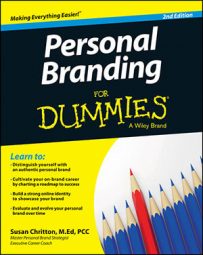These pieces of your personal brand profile are probably the most important (no pressure!), so you want to take your time and get them right before you start to communicate with your target audience.
Identifying your unique promise of value
Your unique promise of value is a promise that you make to your target market that your brand will fulfill. It’s the personal aspect of your brand that is aligned with your mission and values. Your promise of value is the essence of what you have to offer and guides you in how you live your personal brand.It clarifies and communicates what makes you special — what makes you different from other people. Crafting this promise requires understanding your values, interests, strengths, and personal qualities and using them to distinguish yourself.
Lida Citroën, in her book Reputation 360 (Palisades Publishing), offers this advice when crafting your brand promise:
Your brand promise should look something like this: “In order to be known for (your desired brand qualities), I will hold myself out to others in this way: (your behavior, actions, attitude); and I will demonstrate authenticity in this way: (how you will let people see you as real, genuine). I will know my brand promise is working when I see this: (benefits, goals you hope to achieve).”
You must be able to live up to your promise of value. You’re always better off under-promising and over-delivering to those you serve. Your brand promise is what you want to be known for. It can be the promise of value of who you are today or it can be written as who you aspire to become.
Here’s an example of a unique promise of value:I am known for my creativity, enthusiasm, and intelligence by serving each client with respect, giving them individual attention, and treating them with unconditional positive regard. I am an expert in my field and use my knowledge to help my clients and students excel. My clients appreciate my solid, grounded approach during times of transition and trust my guidance through the process.
Move from your promise to your personal brand statement
After you’re satisfied with what you’ve developed as your unique promise of value, you can turn your attention to writing the all-important personal brand statement.When you work on your own statement, keep in mind the central themes that emerge and think about your attributes. Then, envision your best self!
To begin your thought process on what your brand might include, answer the following questions:-
What three or four keywords describe your essential qualities quickly and clearly?
-
What is your essence factor, the core of who you are? “I know I am in my element when __________.”
-
What is your authority factor, the knowledge that you hold and skills that you possess? “People recognize my expertise in _________.”
-
What is your superstar factor, the qualities that set you apart? (This factor is how you get things done or what you’re known for.) “People comment on my ability to ___________.”
Pepper your statement with “wow” words
When writing your personal brand statement, you want to use words that best describe what you offer. The words you use should highlight your emotional attributes and motivate you so that you can deliver that brand to your target audience.Then, to communicate the action in your message, add key verbs like the ones listed here.
| Accomplish | Analyze | Articulate | Budget |
| Calculate | Capitalize | Classify | Close |
| Collaborate | Communicate | Conceptualize | Conclude |
| Decrease | Demonstrate | Distribute | Educate |
| Empower | Engineer | Enhance | Examine |
| Exceed | Generate | Identify | Influence |
| Integrate | Listen | Manufacture | Mastermind |
| Maximize | Navigate | Network | Organize |
| Pilot | Pioneer | Prospect | Rebuild |
| Redesign | Reengineer | Rehabilitate | Simplify |
| Slash | Sold | Strategize | Supervise |
| Systematize | Teach | Transition | Upgrade |
Drafting your statement
To give you a sense of what a personal brand statement could look like, here are examples:- I am passionate about the development of people and am able to lighten the mood with my humor. I enjoy bringing that competitive spirit to solving my clients’ key advertising problems. The continuous challenge to learn fuels my love of accumulating knowledge.
- Driven by the energy of connections to others, I apply my solid intelligence as the interpreter of complex issues to create practical solutions while bringing a sense of fun into every situation.
- Grounded in my core beliefs, I identify the patterns and am able to look strategically into the future with a global perspective.
- Analyzing the DNA blueprint for my clients, I act as the bond between science and business to find opportunities by joining people and businesses through unique value-added insights.
- Acting as the conductor to the orchestra of people that I lead, I bring the pieces together to close
- I am the visionary sales leader of the South American practice. my customers count on me to navigate the complexities of multinational business. I am admired for not only how I lead my high-growth business but also for my work in the community in creating pathways out of poverty for those that I serve.
I bring creativity and enthusiasm into the lives of professionals using my expertise in career development and personal branding with an intelligent, customized approach.Gather keywords to use as a starting point for writing your statement, and then let it simmer until you know how you want to express yourself.

